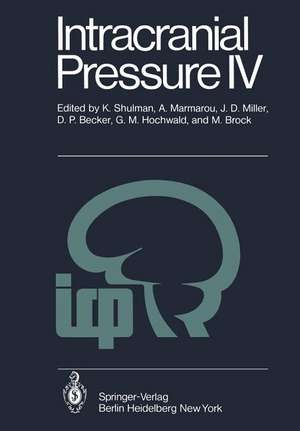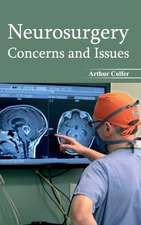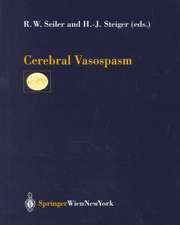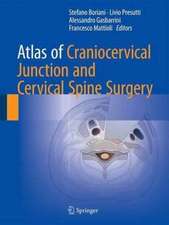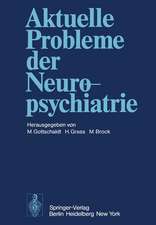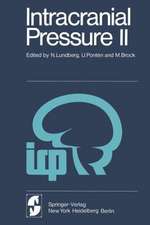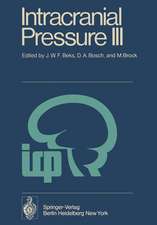Intracranial Pressure IV: Proceedings of the Fourth International Symposium on Intracranial Pressure. Held at Williamsburg/Virginia, USA, June 10-14, 1979
Editat de K. Shulman, A. Marmarou, J. D. Miller, D. P. Becker, G. M. Hochwald, M. Brocken Limba Engleză Paperback – 20 ian 2012
Preț: 744.25 lei
Preț vechi: 783.43 lei
-5% Nou
Puncte Express: 1116
Preț estimativ în valută:
142.41€ • 148.99$ • 118.30£
142.41€ • 148.99$ • 118.30£
Carte tipărită la comandă
Livrare economică 03-17 aprilie
Preluare comenzi: 021 569.72.76
Specificații
ISBN-13: 9783642675454
ISBN-10: 364267545X
Pagini: 720
Ilustrații: XVIII, 698 p.
Dimensiuni: 170 x 244 x 38 mm
Greutate: 1.13 kg
Ediția:Softcover reprint of the original 1st ed. 1980
Editura: Springer Berlin, Heidelberg
Colecția Springer
Locul publicării:Berlin, Heidelberg, Germany
ISBN-10: 364267545X
Pagini: 720
Ilustrații: XVIII, 698 p.
Dimensiuni: 170 x 244 x 38 mm
Greutate: 1.13 kg
Ediția:Softcover reprint of the original 1st ed. 1980
Editura: Springer Berlin, Heidelberg
Colecția Springer
Locul publicării:Berlin, Heidelberg, Germany
Public țintă
ResearchDescriere
This book contains the papers delivered at the Fourth International Symposium on Intracranial Pressure, held at Williamsburg, Virginia, USA, June 10-14, 1979. Divided into 12 sessions, they reflect the most recent developments in areas such as head injuries, pressure volume studies, cerebrovascular complications, intracranial hemor rhage, brain edema, systemic factors and infectious processes, data recording and analysis, CSF formation and absorption, hydroce phalus, clinical aspects of ICP monitoring, anesthesia and intra cranial pressure, treatment with barbiturates and steroids, and os motherapy. The book concludes with a summary of the present state-of-the-art in the field as a whole by Dr. Langfitt. There were two innovations at this Symposium. The first of these was poster sessions, the second, breakfast seminars. This volume contains all papers read plus all those presented as posters, and for this reason contains more pages than the three previous volumes. The organizers wish to thank the Advisory Committee for the work done in paper selection and focus of the Conference. Appreciation is also given to the Chairmen and Co-chairmen of the sessions for the preparation of summary statements. Manuscript preparation was performed by Ms. Lucille Browne, and gratitude is expressed to her. The next Symposium, the Fifth International Conference on ICP, will be held in Japan in 1982. We also wish to acknowledge the technical help of Springer-Verlag and their celerity in producing this volume. The Editors VII Contents Session I. Head Injury Chairman: D. P. BECKER; Co-chairman: I. PAPO 3 Summary . . . . . . . . . . . ..
Cuprins
Session I. Head Injury.- Summary.- ICP and Outcome in Patients with Severe Head Injury.- Prognostic Significance of Intracranial Pressure and Neurological Condition in Acute Brain Lesions.- Role of ICP Monitoring in Patients Suffering from Severe Brain Injuries.- Brain Damage in Fatal Non-Missile Head Injury Without Neuropathological Evidence of High ICP.- Relations of Cerebral Perfusion Pressure and Hematocrit with Hemispheric Cerebral Blood Flow During Post-Traumatic Coma.- ICP in Experimental Head Injury.- Time Course in Intracerebral Traumatic Hematomas.- Operate or Observe? ICP and the Management of the ‘Silent’ Traumatic Intracranial Haematoma.- Brain Interstitial Fluid Pressure Measurement in Head Injury Patients.- Relevance of Cat-Scan for the Level of ICP in Patients with Severe Head Injury.- Can CT Scan Findings Predict Intracranial Pressure in Closed Head Injury Patients?.- Factors Influencing Survival and Quality of Survival in Patients Treated for Elevated Intracranial Pressure.- The Prognostic Value of Intracranial Pressure (ICP) Measurement in Relation to the Different Factors that Can Affect ICP.- Does the Pressure-Volume Relationship Exist?.- Experimental Brain Injury in the Dog: Pathophysiological Correlation.- Correlations Between Intracranial Pressure, Neurologic Deficit and Computer Tomographic Findings in Patients with Acute Severe Head Injury. A Clinical Study.- Continuous Measurement of Intracranial Pressure in 127 Severe Head Injuries.- Session II. Pressure-Volume Studies.- Summary.- The Pressure-Volume Function of Brain Elasticity and its Relationship with Ventricular Size.- A Method for Predicting PVI in Normal Patients.- Drastic Dehydration as a Treatment of Intracranial Hypertension in Severe Head Injuries.- The CSF Pressure-Volume Relationship Before and After Cardiac Arrest.- CSF Pressure-Volume Relation and Pulse Related CSF Pressure Variations in Man.- Effects of Cerebral Edema Upon Viscoelastic Properties of Brain Tissue.- Parameters for Identifying Brain Response Properties in vivo.- Dynamics of Transtentorial Herniation.- Intrabrain Pressure, Cerebrospinal Ruid Pressure and the PV Function of Craniospinal System Elasticity in Patients After the Extraction of Tumors from the Basal Region and Posterior Fossa.- Clinical Experiences with Intracranial Volume-Pressure Response.- A Diagrammatic, Two-Dimensional Model for Interpretation of Craniospinal P/V Interactions.- Etiology of B-Waves.- Session III. Cerebrovascular Aspects.- Summary.- Intracranial Pressure and Regional Cerebral Blood Row Responses to Experimental Brain Retraction Pressure.- Electrophysiological Changes Associated with Local Brain Compression.- Influence of Mild Hypercapnia on Intracranial Pressure in Ischemic, Non-Infarcted Brain Tissues.- Simultaneous Subacute Measurement of ICP and Brain O2 Availability.- Intracranial Dynamics Associated with Experimentally Induced Pressure Waves.- Sympathetic Role of Posterior Hypothalamus in the Development of Acute Brain Swelling.- The CSF Pulse Pressure in Relation to Intracranial Elastance and Failure of Autoregulation.- Effects of Hypercapnia and Systemic Arterial Hypo- and Hypertension on the Interrelation Between CSF Pulse Pressure and Volume-Pressure Response.- The Effect of Blood Pressure and PaCO2 Upon Bulk Compliance (PVI).- Spectral Analysis of Intracranial Pressure.- The Analogy Between CSF Pulse Pressure and Volume-Pressure Response.- Brain Stem — Cerebellar and Hemispheric Blood Row in Stupor and Impaired States of Responsiveness with and without Intracranial Hypertension.- Measurement of Regional Cerebral Blood Volume by Photoelectric Method.- ICP and EEG in Various Forms of Cerebral Seizures.- Analysis of the Wave Pattern of CSF Pulse Wave.- Study of the CSF Pulsation Transfer: Application to the Frequency Analysis.- Blood Pressure Factors Causing Raised ICP.- Session IV. Intracranial Hemorrhage.- Summary.- ICP Time Course in Primary Intracerebral Hemorrhage.- The Effect of Experimentally Produced Intracranial Hematoma Upon ICP.- Intraventricular Pressure, CSFLactateandVasospasminRupturedlntracranial Aneurysm.- Intracranial Pressure Changes in Patients with Diffuse Cerebral Vasospasm.- Continuous Monitoring of CSF Pressure in Acute Subarachnoid Hemorrhage.- Polygraphic Study of CSF Pressure Waves During Coma.- Hydrocephalus Following Early Operation of Ruptured Cerebral Aneurysms: Significance of Long-Term Monitoring of Intracranial Pressure.- Alterations of CSF Hydrodynamics Following Meningitis and Subarachnoid Hemorrhage.- Impaired Absorption of CSF During Experimental Subarachnoid Hemorrhage: Effects of Blood Components on Vesicular Transport in Arachnoid Villi.- Session V. Brain Edema.- Summary.- The Time Course of Brain Tissue Compliance and Resistance in a Controlled Model of Brain Edema.- The Role of Brain Tissue Pressure in Autoregulation of CBF in Areas of Brain Edema.- Quantified Regional Cerebral Glucose Consumption, rCBF and Edema, and the Effects of Papaverine, in Cats with Cortical Cold Injury.- Evolution of Intracranial Pressure and Cerebral Blood Flow in Cryogenic Cerebral Edema.- The Response to Multiple Therapeutic Modalities in Experimental Vasogenic Edema.- Decompressive Craniectomy, ICP and Brain Edema.- Intracranial Pressure and Brain Water Content in Acute Graded Experimental Cerebral Trauma.- Brain Edema in Ischemic Stroke and Air Embolism.- CSF-Pressure of Rats During Ventriculo-Cisternal Perfusion with Potential Brain Edema Factors.- ICP Changes Following Sudden Decompression of the Cat Brain.- Different Aspects of a New Model of Intracranial Hypertension on the Dog Induced by a Blood Shift.- Brain Free Fatty Acids After Transient Global Brain Ischemia with Postinsult Thiopental Therapy.- An Autoradiographic Study of Capillary Permeability During Hyperosmotic Opening.- Freeze Lesion of the Cerebrum: Local Capillary Permeability, Blood Flow and Bulk Flow of Edema Fluid.- Inhibition of Oxygen Diffusion as a Major Cause of Prolonged Cell Anoxia and Postishemic ICP Elevation.- Session VI. Systemic Factors and Infectious Processes.- Summary.- Systemic Vasopressor Responses and the Arterial Hypoxemia Associated with Increased Intracranial Pressure.- Sequential Hemodynamic Changes in Experimental Neurogenic Pulmonary Edema.- Separate and Combined Effects on Intracranial Pressure of Changes in PO2 and PCO2.- The Role of the Hypothalamo-Hypophysial Neurosecretory Adrenergic System in Cushing Reflex.- Intracranial Pressure, Brain Edema and Regional Metabolism in Experimental Brain Abscess in Cats.- Bacterial Meningitis: Changes in Cerebrospinal Fluid Outflow Resistance.- Experiences with ICP Monitoring in India.- ICP and Compliance in Chronic Subdural Hematoma.- Pathogenesis of Chronic Subdural Hematoma. ICP, Biochemical and Morphological Findings.- Session VII. Data Recording and Analysis.- Summary.- Extradural, Ventricular and Subdural Pressure Recording. Comparative Clinical Study.- Simultaneous Epidural and Intraventricular Pressure Measurement During the Occurrence of Supratentorial Expanding Lesions.- Measurement of Intracranial Force Vector and Its Significance.- Clinical Evaluation of a New Epidural Pressure Transducer.- intracranial Pressure Monitoring: Chronic Animal Implantation and Preliminary Patient Experience with an Implantable Telemetered System.- Intracranial Pressure Studies in Acutely Ill Neonates Using a Noninvasive Technique: A Three Year Experience.- The Control of ICP Using Three Asynchronous Closed Loops.- A Combination of Bed Side ICP Recordings; Histogram, Trend-Graph, and Digital Print.- Intracranial Pressure Registration Administrated by a Microprocessor.- A Microcomputer System for ICP Analysis.- Epidural Measurement of Intracranial Pressure.- A Newly Devised Transducer for Epidural Pressure Measurement and Its Clinical Use.- Spectral Analysis of the ICP Signal — Practical Application in Computer-Assisted Long-Term Patient Care.- Chronic ICP Monitoring Utilizing an in Vivo Calibrating Sensor.- Data Display for Intracranial Pressure Monitoring.- The Integration of ICP with Other Monitoring Signals on a Single Computer Data Base.- Long Term Study of ICP with Implanted Sensors in Patients with Brain Tumor.- Clinical Application of Telemetrie Intracranial Pressure Monitoring.- Session VIII. CSF Formation and Absorbtion.- Summary.- Neurogenic Control of CSF Production from the Choroid Plexus.- Changes in Resistance to Cerebrospinal Fluid Absorption During Prolonged Infusion Studies.- Lumbar Sac Infusion Test Revisited.- Comparison of CSF Outflow Resistance Determined by Bolus and Steady-State Techniques.- The Correlation of Overnight Ventricular Fluid Pressure Recording with Serial Metrizamide Ventriculography in Hydrocephalus.- Differential Effects of Pentobarbital, Ketamine Hydrochloride, and Enflurane Anesthesia on CSF Formation Rate and Outflow Resistance in the Rat.- Cerebrospinal Fluid Formation Rate in Cold Induced Brain Edema.- Cortical Bulk Flow in Normal and Hyposmolar Edema.- Session IX. Hydrocephalus.- Summary.- Hydrodynamic Properties of CSF Shunt Systems.- A Device for Telemetric Pressure Measurement in Shunt Systems.- Intracranial Pressure Changes in “Arrested” Hydrocephalus.- Predicting the Results of Ventricular Shunting in Normal Pressure Hydrocephalus by Lumbo-Ventricular Perfusion Test.- Intraventricular Pressure Waves — The Best Predictive Test for Shunting in Normal Pressure Hydrocephalus.- ICP, Cat Scans and Psychometric Assessment in Dementia: A Prospective Analysis.- Long-Term Intraventricular Pressure Measurement in Chronic Communicating Hydrocephalus.- Intraventricular Pressure Monitoring and CSF Dynamics in Non-Tumor Aqueductal Stenosis.- Quantitative Determination of CSF-Flow in Diagnosis of CSF-Resorption Disorders.- The Pathophysiology of Intracranial Hypertension/Hypotension.- Outflow Possibilities of Ventriculolymphatic Shunt.- Plateau Waves: Production in the Rat and Simulation by Means of a Mechanical Model.- Session X. Clinical Aspects of ICP Monitoring.- Summary.- Benign Intracranial Hypertension: A Clinical Evaluation of the CSF Absorption Mechanisms.- Benign Intracranial Hypertension Secondary to Vitamin A Deficiency in Rat and Man: Reversible Collagenous Obstruction of CSF Outflow by Metabolically Deranged Fibroblasts.- Benign Intracranial Hypertension: Therapeutical Approach and Pathophysiological Implications.- ICP Monitoring in Benign Intracranial Hypertension.- Experience in Management of Critical Patients with Reye-Johnson Syndrome.- Intracranial Hypertension in Patients with Reye Syndrome.- The Effect of Decerebrate Rigidity on ICP as Modified by Brain Elastance.- Relationship of Nurse/Patient Activity and ICP Variation.- Pathological Intracranial Pressure Waves in Arnold Chiari Malformations.- Continuous Recording of ICP in the Normal Monkey.- The Results of ICP and EEG Monitoring of Sleep in Cases of Patients with Supratentorial Brain Tumors.- Relationship Between Rapid ICP Variation, Respiratory Pattern and Wakefulness in Neurological Patients.- Selection of Patients for Intracranial Pressure Monitoring and Control.- Session XI. Anesthesia and Intracranial Pressure.- Summary.- Lidocaine Prevents Increased ICP After Endotracheal Intubation.- Incompatibility of Halogenated Anesthetics with Brain Surgery.- The Effects of Nitrous Oxide, Althesin and Thiopentone on Intracranial Pressure During Chest Physiotherapy in Patients with Severe Head Injuries.- Effect of Althesin on Intracranial Hypertension in Patients with Severe Head Injury.- Nitroprusside and Nitroglycerin Induced Intracranial Pressure Changes.- Effects of Enflurane and Halothane on ICP in Dogs.- Effect of Some Analgesics, Sedatives and i.v. Anesthetics on ICP in Man.- Session XII. Barbiturate, Steroid, and Osmotherapy.- Summary.- Barbiturates for Intracranial Hypertension: A Ten Year Perspective.- The Effectiveness of Iatrogenic Barbiturate Coma in Controlling Increased ICP in 61Children.- Effects of Barbiturates on Intracranial Pressure and the Amount of Mannitol Required to Control the Intracranial Pressure.- Cerebral Vasospasm, ICP and Barbiturate Coma.- Effect of Megadose Steroids on ICP in Traumatic Coma.- Influence of Large Doses of Steroids on Brain Compression, Epidurally.- Mannitol Response and Histogram Analysis in Raised ICP.- Methodology for the Control of Intracranial Pressure with Hypertonic Mannitol.- Effect of Infusion Rate of Glycerol, Mannitol and Urea on Regional Brain Dehydration in the Rat.- The Effects of Furosemide on CSF Dynamics in Patients with Pseudotumor Cerebri.- Effect of Tham on ICP, EEG and Tissue Edema Parameters in Experimental and Clinical Brain Edema.- Closing Discussion: “Where Have We Been, Where Are We Now, and Where Do We Go From Here?”.- List of Senior Authors.- Author Index.
